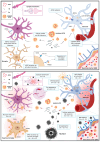ApoE: The Non-Protagonist Actor in Neurological Diseases
- PMID: 39596597
- PMCID: PMC11593850
- DOI: 10.3390/genes15111397
ApoE: The Non-Protagonist Actor in Neurological Diseases
Abstract
Background: Apolipoprotein E (APOE = gene, ApoE = protein) is a glycoprotein involved in the biological process of lipid transportation and metabolism, contributing to lipid homeostasis. APOE has been extensively studied for its correlation with neurodegenerative diseases, in particular Alzheimer's disease (AD), where the possession of the epsilon 4 (E4) allele is established as a risk factor for developing AD in non-familiar sporadic forms. Recently, evidence suggests a broad involvement of E4 also in other neurological conditions, where it has been shown to be a predictive marker for worse clinical outcomes in Parkinson's disease (PD), brain trauma, and disturbances of consciousness. The mechanisms underlying these associations are complex and involve amyloid-β (Aβ) peptide accumulation and neuroinflammation, although many others have yet to be identified.
Objectives: The aim of this review is to overview the current knowledge on ApoE as a non-protagonist actor in processes underlying neurodegenerative diseases and its clinical significance in AD, PD, acquired brain trauma, and Disorders of Consciousness (DoC). Ethical implications of genetic testing for APOE variants and information disclosure will also be briefly discussed.
Keywords: Alzheimer’s disease; Parkinson’s disease; apolipoprotein E; brain injury; dementia; neurodegenerative diseases; neuroinflammation; stroke.
Conflict of interest statement
The authors declare no conflicts of interest.
Figures



References
-
- Strittmatter W.J., Saunders A.M., Schmechel D., Pericak-Vance M., Enghild J., Salvesen G.S., Roses A.D. Apolipoprotein E: High-avidity binding to β-amyloid and increased frequency of type 4 allele in late-onset familial Alzheimer disease. Proc. Natl. Acad. Sci. USA. 1993;90:1977–1981. doi: 10.1073/pnas.90.5.1977. - DOI - PMC - PubMed
-
- Corder E.H., Saunders A.M., Strittmatter W.J., Schmechel D.E., Gaskell P.C., Small G.W., Roses A.D., Haines J.L., Pericak-Vance M.A. Gene dose of apolipoprotein E type 4 allele and the risk of Alzheimer’s disease in late onset families. Science. 1993;261:921–923. doi: 10.1126/science.8346443. - DOI - PubMed
Publication types
MeSH terms
Substances
LinkOut - more resources
Full Text Sources
Medical
Miscellaneous

